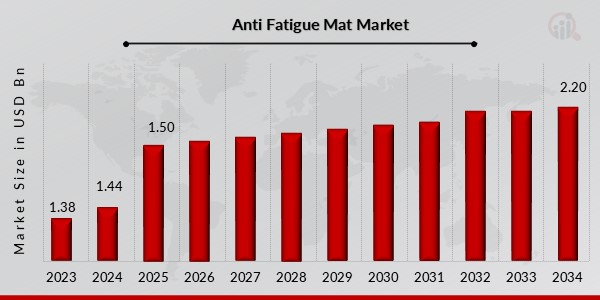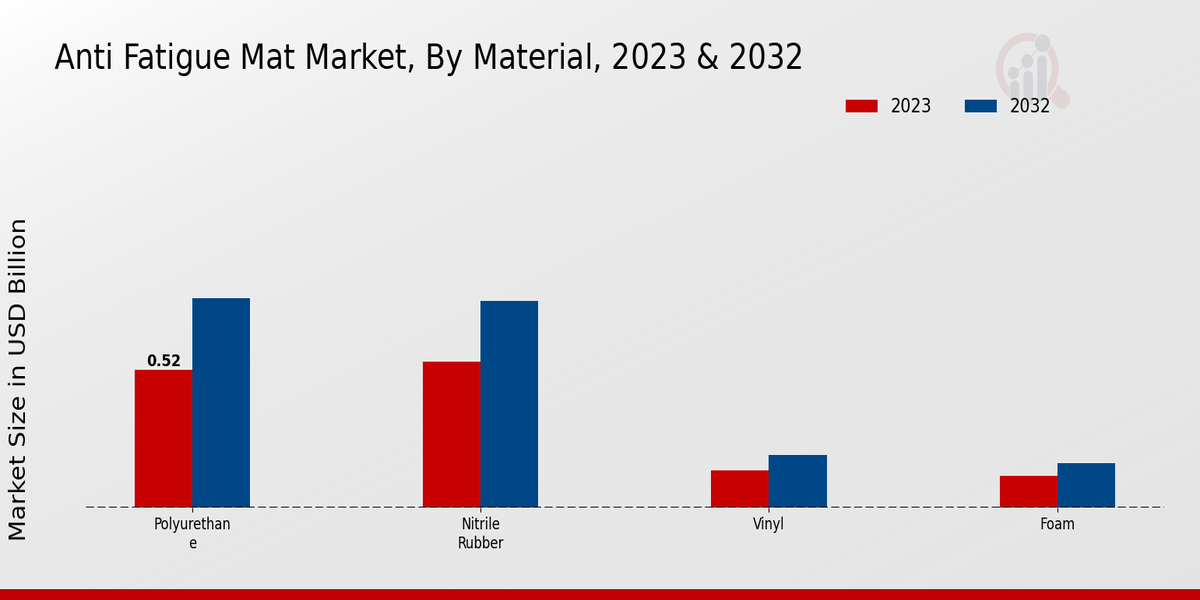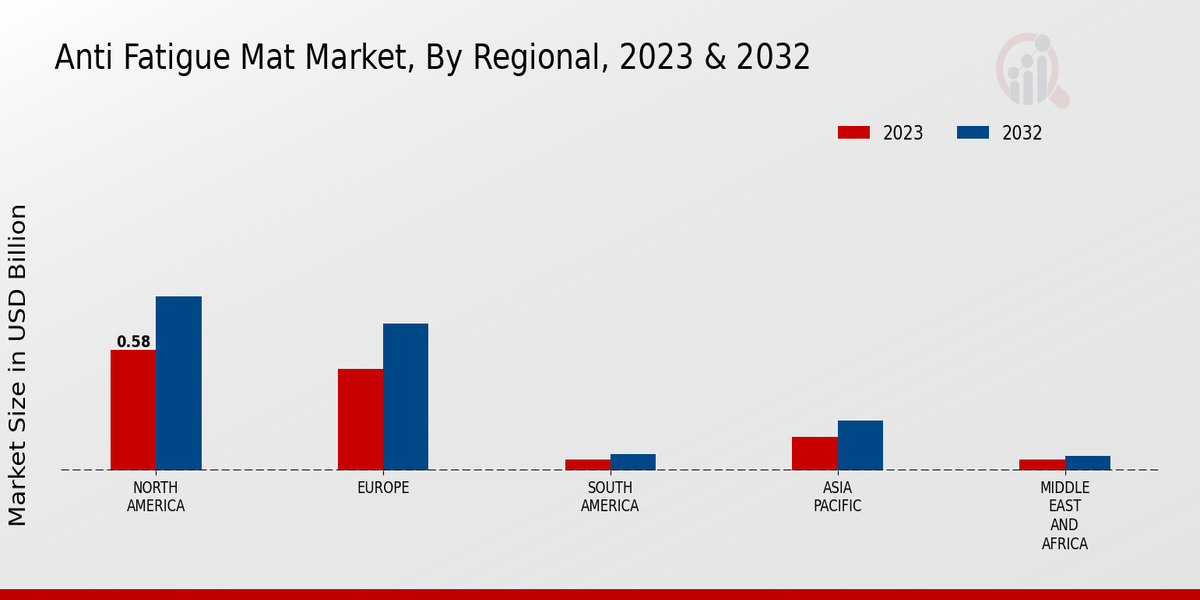Global Anti Fatigue Mat Market Overview
Anti Fatigue Mat Market Size was estimated at 1.44 (USD Billion) in 2024. The Anti Fatigue Mat Industry is expected to grow from 1.50 (USD Billion) in 2025 to 2.20 (USD Billion) by 2034. The Anti Fatigue Mat Market CAGR (growth rate) is expected to be around 4.3% during the forecast period (2025 - 2034).

Source: Primary Research, Secondary Research, MRFR Database and Analyst Review
Key Anti Fatigue Mat Market Trends Highlighted
Growing industrialization and automation led to prolonged standing or walking, increasing the demand for anti-fatigue mats. These mats provide ergonomic support, reducing muscle fatigue, back pain, and workplace accidents. The need for improved employee safety and well-being in various industries, such as manufacturing, healthcare, and retail, drives market growth.
Furthermore, increasing awareness about workplace ergonomics and the benefits of anti-fatigue mats creates new opportunities for market expansion. Manufacturers focus on developing innovative products with enhanced features, such as anti-microbial and anti-slip properties, to meet the specific needs of various workplaces. Additionally, the rising popularity of sit-stand desks and other ergonomic furniture supports the integration of anti-fatigue mats for a more comfortable and productive work environment.
Anti Fatigue Mat Market Drivers
Growing Awareness of Workplace Ergonomics
General awareness of the importance of workplace ergonomics is increasing year by year. The reason for this phenomenon is the lifestyle changes of people, which may lead to a variety of health issues. One of the major reasons is the increasing number of sedentary jobs as nowadays people can work from home or from the office. It is possible to define a range of common health problems that can be caused by sedentary work, including back pain, neck pain, and eye strain.That is why, nowadays, the need for products that ameliorate workplace ergonomics is growing. Anti-fatigue mats are supposed to reduce the amount of stress put on a human body, as these products presuppose standing on a soft and cushioned surface. This approach is likely to decrease fatigue, improve blood circulation and avoid pain. Moreover, as the number of work-related injuries decreases, productivity at work will increase. That is why, as the awareness of workplace ergonomics will be growing, the market for anti-fatigue mats is likely to grow as well.
Rising Demand for Anti-Fatigue Mats in Healthcare Settings
The healthcare industry is a major consumer of anti-fatigue mats. This is because healthcare workers often spend long hours on their feet, which can lead to fatigue and pain. Anti-fatigue mats can help to reduce these problems by providing a soft, cushioned surface to stand on. This can help to improve circulation, reduce fatigue, and prevent pain. In addition, anti-fatigue mats can also help to improve safety in healthcare settings by reducing the risk of slips and falls.
Increasing Popularity of Anti-Fatigue Mats in the Industrial Sector
Another vital sector in which anti-fatigue mats are in use is the industrial sector. This is because many of the tasks done by industrial workers are done in conditions that can be considered as harsh. With time, this leads to a lot of fatigue and possible pain. Anti-fatigue mats help curb this by providing a spongy surface on which workers can stand. This, in turn, facilitates better circulation and drastically reduces fatigue. Even better, the mats reduce the number of workplace injuries as well.
Anti Fatigue Mat Market Segment Insights
Anti Fatigue Mat Market Material Insights
The market for anti-fatigue mats is segmented on the basis of materials such as Polyurethane, Nitrile Rubber, Vinyl, and Foam. Among these, the segment Polyurethane accounted for the highest market share in 2023 and is anticipated to dominate throughout the forecast period. Polyurethane anti-fatigue mats provide a combination of comfort, durability and resistance to wear and tear; hence, they are largely used in industrial and commercial applications. Another popular choice is the Nitrile Rubber anti-fatigue mats, which are mainly used in areas where there is a requirement for chemical resistance.These mats are known for their durability and are designed to withstand exposure to oils, solvents, and other harsh chemicals. The Vinyl anti-fatigue mats are highly popular in the market due to their relatively low cost and being easy to clean and maintain. This type of mat is generally used in retail stores, offices and other public places. The market is segmented based on material and on the basis of geographical region. The increase in demand is primarily due to growth in awareness about the health benefits of anti-fatigue mats, including reduced foot and lower back pain and improved employee comfort and productivity.With the growing use of standing desks and workstations, the market for anti-fatigue mats will continue to grow. The demand for these mats has also been fueled due to advanced materials that include gel-filled mats and mats incorporating heating, cooling and other such technologies.

Source: Primary Research, Secondary Research, MRFR Database and Analyst Review
Anti Fatigue Mat Market Application Insights
The Application Segment of the Anti Fatigue Mat Market is a very important part of defining the dynamics of market development. In particular, the industrial application segment plays a major role. This is so because there is a demand for these products in the manufacturing and industrial facilities, warehouses, and other production sites where people stand for long periods. These mats help to avoid fatigue, thus improving productivity and avoiding incidents. As for commercial applications, these occupy a substantial part of such establishments as offices, shops, and others.People who perform work that requires them to be on their feet for quite a long period of time would enjoy feeling more relaxed. However, residential applications are likely to become increasingly popular as we all strive to adjust our homes ergonomically, and the overall demand for anti-fatigue mats in this sector will be growing. The Anti Fatigue Mat Market application-segment based is an important aspect that shows the dynamics of the demand and, by this means, offers opportunities for manufacturers and distributors.
Anti Fatigue Mat Market Design Insights
The Design segment of the Anti Fatigue Mat Market is categorized into Standard, Custom, and Ergonomic designs. Standard Anti Fatigue Mats are commonly used in various industrial and commercial settings, offering basic comfort and support. Custom Anti Fatigue Mats, on the other hand, are tailored to specific requirements, such as size, shape, and color, meeting unique customer needs. Ergonomic Anti Fatigue Mats are designed with advanced features to enhance comfort and reduce fatigue, incorporating elements like beveled edges, raised surfaces, and anti-slip properties.The Standard Anti Fatigue Mat segment held a significant share of the market in 2023, owing to its widespread adoption in general-purpose applications. However, the Custom Anti Fatigue Mat segment is projected to witness substantial growth during the forecast period, driven by increasing demand for customized solutions in specialized industries. The Ergonomic Anti Fatigue Mat segment is also expected to gain traction as businesses prioritize employee health and well-being.
Anti Fatigue Mat Market Thickness Insights
The thickness segment is of crucial importance in the Anti Fatigue Mat Market, influencing market growth and providing valuable insights into consumer preferences and industry trends. In 2023, the Thin (1/2 inch) segment held a dominant position in the market, accounting for approximately 45% of the revenue. Its popularity stems from its versatility and suitability for various applications, including light industrial settings, retail stores, and home offices. The Medium (1/2-1 inch) segment is projected to witness steady growth over the forecast period, driven by increasing demand from healthcare facilities, commercial kitchens, and manufacturing plants.These mats offer enhanced comfort and support for individuals standing for extended durations, reducing fatigue and improving productivity. The Thick (>1 inch) segment, though accounting for a smaller market share, is gaining traction in heavy industrial environments, construction sites, and other applications where maximum support and durability are paramount. Its ability to withstand heavy loads and provide exceptional cushioning makes it a preferred choice in these demanding settings. Overall, the Thickness segment in the Anti Fatigue Mat Market is expected to remain dynamic, with each segment catering to specific industry needs and consumer preferences.The market segmentation provides valuable insights for manufacturers and distributors to tailor their offerings and strategies to meet the diverse requirements of the industry.
Anti Fatigue Mat Market Shape Insights
The shape segment of the Anti Fatigue Mat Market is categorized into rectangular, circular, and custom shapes. Rectangular mats are the most popular, accounting for over 60% of the market share in 2023. Their popularity stems from their versatility and wide range of sizes, making them suitable for various applications. Circular mats, with a market share of approximately 25%, are preferred in areas where aesthetics and space optimization are crucial. Custom-shaped mats cater to specific requirements and dimensions, offering a market share of around 15%.The increasing demand for ergonomic and customized solutions in workplaces and industrial settings is driving the growth of the shape segment in the Anti Fatigue Mat Market, which is projected to reach a valuation of 1.5 billion USD by 2024.
Anti Fatigue Mat Market Regional Insights
The regional segmentation of the Anti Fatigue Mat Market offers valuable insights into the geographical distribution of market growth. North America dominates the market, accounting for a significant share of the Anti Fatigue Mat Market revenue in 2023. The region's well-established industrial sector and high consumer spending power contribute to its market dominance. Europe holds the second-largest market share, driven by stringent safety regulations and a focus on workplace ergonomics. The Asia-Pacific region is projected to witness substantial growth over the forecast period, owing to rapid industrialization and rising disposable incomes.South America and the Middle East and Africa (MEA) regions represent emerging markets with untapped potential for Anti Fatigue Mat Market growth. These regions offer opportunities for manufacturers to expand their presence and cater to the growing demand for workplace safety and comfort solutions.

Source: Primary Research, Secondary Research, MRFR Database and Analyst Review
Anti Fatigue Mat Market Key Players And Competitive Insights
The major players in Anti Fatigue Mat Market are continuously involved in Anti Fatigue Mat Market development. This means that companies introduce new products to the market to stay competitive and enhance the quality of the already existing products. The main feature of the present Anti Fatigue Mat Market is that major leaders in the market strive to develop new products. Moreover, recent market trends show that leading players become more engaged in strategic partnerships and acquisitions. For instance, 3M has recently acquired Scott Safety. It is evident that the market of Anti Fatigue Mat will remain competitive in the next few years as the major players continue investing in research and development.Company 3M offers the customer a wide range of products, including anti-fatigue floor mats, anti-fatigue runners, and anti-fatigue insoles –orthopedic and orthotic inserts for footwear. The company is known for offering comfort and support to the workers who have to stand throughout the day. The 3M Company provides an industrial source supply division, which includes a variety of products for workers, industrial supplies, and building safety materials. 3M also has interests in the healthcare and consumer products sectors and operates in more than two hundred countries. Kimberly-Clark also strives to provide people with comfort and support using such products as, for example, anti-fatigue floor mats and runners or insoles. The products are being used by workers who have to stand all day. The American company also offers a variety of other products, including diapers, wipes, and paper towels. Kimberly-Clark operates in more than one hundred and seventy countries.
Key Companies in the Anti Fatigue Mat Market Include
-
Ansell Ltd.
-
Sioen Industries
-
Kimberly-Clark Corporation
-
SCA Hygiene Products AB
-
3M Company
-
Lakeland Industries, Inc.
-
Molnlycke Health Care AB
-
Svenska Cellulosa AB
-
Cardinal Health
-
Freudenberg Group
-
PDI Healthcare
-
Polypore International, Inc.
-
North American Health Care
-
Tena
Anti Fatigue Mat Market Industry Developments
The anti-fatigue mat market is projected to reach USD 1.94 billion by 2032, exhibiting a CAGR of 4.32% during the forecast period (2024-2032). Increasing awareness of workplace ergonomics and the growing prevalence of musculoskeletal disorders are driving market growth. Moreover, the rising adoption of anti-fatigue mats in various industries, including healthcare, manufacturing, and retail, is fueling demand. Technological advancements, such as the development of mats with improved durability and comfort, are also contributing to market expansion. Recent developments include the launch of anti-fatigue mats with antimicrobial properties and the integration of sensors for monitoring employee movement and posture. These innovations are expected to further drive market growth in the coming years.
Anti Fatigue Mat Market Segmentation Insights
Anti Fatigue Mat Market Material Outlook
-
Polyurethane
-
Nitrile Rubber
-
Vinyl
-
Foam
Anti Fatigue Mat Market Application Outlook
-
Industrial
-
Commercial
-
Residential
Anti Fatigue Mat Market Design Outlook
-
Standard
-
Custom
-
Ergonomic
Anti Fatigue Mat Market Thickness Outlook
-
Thin (1/2 inch)
-
Medium (1/2-1 inch)
-
Thick (>1 inch)
Anti Fatigue Mat Market Shape Outlook
-
Rectangular
-
Circular
-
Custom
Anti Fatigue Mat Market Regional Outlook
-
North America
-
Europe
-
South America
-
Asia Pacific
-
Middle East and Africa
| Report Attribute/Metric |
Details |
| Market Size 2024 |
1.44 (USD Billion) |
| Market Size 2025 |
1.50 (USD Billion) |
| Market Size 2034 |
2.20 (USD Billion) |
| Compound Annual Growth Rate (CAGR) |
4.3% (2025 - 2034) |
| Report Coverage |
Revenue Forecast, Competitive Landscape, Growth Factors, and Trends |
| Base Year |
2023 |
| Market Forecast Period |
2025 - 2034 |
| Historical Data |
2019 - 2023 |
| Market Forecast Units |
USD Billion |
| Key Companies Profiled |
Ansell Ltd., Sioen Industries, KimberlyClark Corporation, SCA Hygiene Products AB,3M Company, Lakeland Industries, Inc., Molnlycke Health Care AB, Svenska Cellulosa AB, Cardinal Health, Freudenberg Group, PDI Healthcare, Polypore International, Inc., North American Health Care, Tena |
| Segments Covered |
Material, Application, Design, Thickness, Shape, Regional |
| Key Market Opportunities |
Increasing demand from the healthcare and hospitality sectorsGrowing awareness of ergonomic solutionsAdoption by industrial and manufacturing sectorsTechnological advancements in mat design and materialsExpansion into emerging markets |
| Key Market Dynamics |
Growing awareness of musculoskeletal disordersIncreasing adoption of ergonomic solutionsRising healthcare costsTechnological advancements |
| Countries Covered |
North America, Europe, APAC, South America, MEA |
Frequently Asked Questions (FAQ) :
The anti-fatigue mat market is expected to reach a valuation of approximately USD 1.44 billion in 2024.
The anti-fatigue mat market is anticipated to grow at a CAGR of 4.3% from 2025 to 2034.
North America is expected to dominate the anti-fatigue mat market throughout the forecast period, owing to the high adoption of ergonomic products in the workplace and increasing awareness about the benefits of anti-fatigue mats.
Anti-fatigue mats are primarily used in industrial and commercial settings, including manufacturing facilities, warehouses, retail stores, offices, and healthcare facilities. They are also gaining popularity in residential applications, such as kitchens and laundry rooms
Some of the key competitors in the anti-fatigue mat market include 3M, Freudenberg, Kimberly-Clark, The Crown Group, and Rubbermaid Commercial Products.
The growth of the anti-fatigue mat market is driven by factors such as rising awareness about the benefits of ergonomic products, increasing adoption of standing desks, and growing demand from industries where workers spend extended periods on their feet
The anti-fatigue mat market faces challenges such as intense competition, the availability of low-cost substitutes, and fluctuating raw material prices.
Key trends in the anti-fatigue mat market include the increasing adoption of sustainable materials, the development of innovative products with advanced features, and the growing popularity of online distribution channels.
The anti-fatigue mat market is projected to reach a valuation of approximately USD 2.20 billion by 2034.
Factors contributing to the growth of the anti-fatigue mat market include increasing awareness about workplace safety and ergonomics, growing demand from emerging markets, and technological advancements leading to the development of innovative products.

















